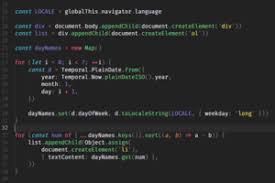Master Java Programming: Learn the Language of Innovation
The Benefits of Learning Java Programming
Java is a versatile and powerful programming language that is widely used in the software development industry. Learning Java can open up a world of opportunities for aspiring programmers. Here are some key benefits of learning Java programming:
Platform Independence
One of the main advantages of Java is its platform independence. Java programs can run on any platform that supports Java without the need for recompilation. This makes Java a popular choice for developing cross-platform applications.
Object-Oriented Programming
Java is an object-oriented programming language, which means it allows developers to model real-world entities as objects. This approach promotes code reusability, modularity, and easier maintenance of large codebases.
Rich API Library
Java comes with a vast standard library that provides ready-to-use classes and methods for common programming tasks. This rich API library saves developers time and effort by offering pre-built solutions for various functionalities.
Strong Community Support
The Java community is large and active, with plenty of resources available for beginners and experienced programmers alike. Online forums, tutorials, and documentation make it easy to find help and guidance when learning Java.
Career Opportunities
Proficiency in Java programming is highly valued in the job market. Many companies seek developers with Java skills to build enterprise applications, web services, mobile apps, and more. Learning Java can enhance your career prospects and open doors to exciting job opportunities.
Start Your Journey in Java Programming Today!
Whether you are a beginner looking to learn your first programming language or an experienced developer seeking to expand your skill set, learning Java can be a rewarding experience. With its versatility, popularity, and robust features, mastering Java programming can propel your career to new heights.
Top 9 FAQs About Learning Java Programming: A Beginner’s Guide
- What is Java programming?
- Why should I learn Java?
- Is Java difficult to learn for beginners?
- What are the key features of Java programming?
- How can I start learning Java programming?
- Are there any recommended resources for learning Java?
- What are the common uses of Java in software development?
- Is it necessary to have a background in programming to learn Java?
- What career opportunities are available for Java programmers?
What is Java programming?
Java programming is a versatile and powerful coding language widely used in software development. Java is renowned for its platform independence, allowing programs to run on various systems without recompilation. It follows an object-oriented programming paradigm, enabling developers to model real-world entities as objects for efficient code organization and maintenance. With a rich standard library offering pre-built solutions for common tasks, Java simplifies development and promotes code reusability. Its strong community support and vast career opportunities make Java an excellent choice for beginners and experienced programmers alike looking to enhance their skills in the ever-evolving tech industry.
Why should I learn Java?
Java is a highly versatile and widely used programming language with a myriad of benefits that make it a popular choice for aspiring programmers. Learning Java offers numerous advantages, such as platform independence, object-oriented programming principles, a rich API library, strong community support, and abundant career opportunities. Whether you are aiming to develop cross-platform applications, leverage the power of object-oriented design, or enhance your job prospects in the competitive tech industry, mastering Java can be a valuable investment in your programming skills and future career growth.
Is Java difficult to learn for beginners?
Many beginners wonder, “Is Java difficult to learn?” While Java is a robust and versatile programming language, its syntax and concepts can be challenging for newcomers. However, with dedication, practice, and the right resources, Java can be mastered by beginners. Taking a structured approach to learning Java, starting with the basics and gradually building upon your knowledge, can make the learning process more manageable and rewarding. With perseverance and a willingness to learn, beginners can overcome the initial hurdles and become proficient in Java programming.
What are the key features of Java programming?
Java programming offers a range of key features that make it a popular choice among developers. Some of the notable features of Java include platform independence, object-oriented programming support, a rich API library, strong community support, and extensive career opportunities. Java’s platform independence allows programs to run on various platforms without recompilation, while its object-oriented nature promotes code reusability and modularity. The extensive standard library in Java simplifies common programming tasks with pre-built solutions. Additionally, the active Java community provides ample resources for learning and development. With its versatility and high demand in the job market, mastering Java programming can pave the way for a successful career in software development.
How can I start learning Java programming?
To start learning Java programming, beginners can follow a structured approach that includes familiarizing themselves with basic programming concepts such as variables, data types, loops, and conditional statements. It is recommended to start with online tutorials, interactive coding platforms, and Java programming books to build a strong foundation. Practice coding regularly by working on small projects and exercises to reinforce understanding. Additionally, joining Java programming communities and forums can provide valuable support and resources for aspiring programmers looking to enhance their skills. By dedicating time and effort to consistent practice and learning, individuals can effectively kickstart their journey into the world of Java programming.
Are there any recommended resources for learning Java?
When it comes to learning Java programming, aspiring developers often seek recommended resources to enhance their skills. There is a plethora of resources available, including online tutorials, textbooks, interactive coding platforms, and community forums dedicated to Java programming. Some popular choices for learning Java include websites like Codecademy, Udemy, and Coursera, which offer comprehensive courses tailored for beginners and experienced programmers alike. Additionally, books such as “Head First Java” by Kathy Sierra and Bert Bates are highly recommended for those looking to delve deeper into the language’s concepts. Ultimately, the best resource for learning Java may vary based on individual learning preferences and goals, so exploring different options can help aspiring programmers find the most suitable resources to master Java programming effectively.
What are the common uses of Java in software development?
Java is a versatile programming language widely utilized in software development for various purposes. Some common uses of Java include building web applications, mobile apps, enterprise software, and desktop applications. Java’s platform independence, robustness, and scalability make it a popular choice for developing large-scale systems that require reliability and performance. Additionally, Java is commonly used in backend development, server-side applications, and data processing tasks due to its strong networking capabilities and extensive standard library. Overall, Java’s flexibility and wide range of applications make it a valuable tool for software developers across different domains.
Is it necessary to have a background in programming to learn Java?
One frequently asked question among beginners interested in learning Java programming is whether a background in programming is necessary to start learning Java. While having prior programming experience can certainly be beneficial, it is not a strict requirement for learning Java. Java is often recommended as a beginner-friendly language due to its readability and extensive documentation. With dedication, practice, and a willingness to learn, individuals with no prior programming background can successfully grasp the fundamentals of Java and build a solid foundation in programming.
What career opportunities are available for Java programmers?
Java programmers have a wide range of career opportunities available to them in today’s job market. With the versatility and popularity of Java as a programming language, skilled Java developers are in high demand across various industries. Career paths for Java programmers include software development, web application development, mobile app development, enterprise solutions, system architecture, and more. Many companies seek Java programmers to build robust and scalable applications that meet their business needs. By mastering Java programming, individuals can unlock exciting career prospects and contribute to innovative projects in the ever-evolving tech industry.







